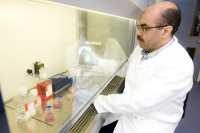28 Sep Manuka Honey May Reduce Harmful Biofilm Formation in Catheters
MedicalResearch.com Interview with:
Dr. Bashir A. Lwaleed PhD, FRCPath, PGCAP, FHEA, CBiol FSB, FIBMS
Faculty of Health Sciences
University of Southampton
South Academic and Pathology Block (MP 11)
Southampton General Hospital
Southampton UK
MedicalResearch.com: What is the background for this study?
Response: The study merges two longstanding interests. We have long worked out of several departments at Southampton and Portsmouth on the therapeutic potential for natural products (including the medium – chain fatty acids GLA (evening primrose oil) and EPA (fish oil) as well as honeys from a number of floral sources. Secondly, there is an established research theme in the Faculty of Healthcare Science at Southampton addressing continence related issues; moreover catheter management as an economic and infection control issue is a major concern in the NHS Trust Urology department. Biofilms on catheters are sources of infection, honey has proven antibacterial (and other therapeutic) properties in topical applications such as skin ulceration. It is a logical step to assess whether a similar use may be made for honey instilled into the bladder and/or flushing the lumen of a catheter.
MedicalResearch.com: What are the main findings?
Response: The findings reported in our recent JCP article suggest that, in a simple in-vitro model, one of the standard medicinal honeys (Manuka) inhibits bacterial attachment to a plastic substrate and reduces growth of organisms already attached.
MedicalResearch.com: What should readers take away from your report?
Response: Honey may be an effective antibacterial and biofilm inhibiting agent in catheter management probably not prone to the induction of resistant pathogens as are many current antibiotics.
MedicalResearch.com: What recommendations do you have for future research as a result of this study?
Response: The work should proceed through assessment of tolerance to intravesical instillation of dilute honey by human bladders, proceeding to trials of its use in catheter management. Further preclinical studies would also involve models of mature biofilms (requiring a flow of medium over the test substrate).
MedicalResearch.com: Is there anything else you would like to add?
Response: Is there anything else you would like to add? Studies on other properties of honey, such as inhibition of mast cell degranulation, may stimulate interest in further intravesical applications, interstitial cystitis being a case in point. These studies rely on the concept of instillation into the bladder being essentially a topical application; the bladder wall structure and physiology is geared to preventing passage of substances from the urine into the body proper or the blood circulation. This may be partially compromised in disease states, so the tolerability studies will need to include patients with some degree of bladder irritation or dysfunction.
MedicalResearch.com: Thank you for your contribution to the MedicalResearch.com community.
Citation:
Somadina Emineke, Alan J Cooper, Sarah Fouch, Brian R Birch, Bashir A Lwaleed. Diluted honey inhibits biofilm formation: potential application in urinary catheter management? Journal of Clinical Pathology, 2016; jclinpath-2015-203546 DOI: 10.1136/jclinpath-2015-203546
Note: Content is Not intended as medical advice. Please consult your health care provider regarding your specific medical condition and questions.
More Medical Research Interviews on MedicalResearch.com
[wysija_form id=”5″]
Last Updated on September 28, 2016 by Marie Benz MD FAAD

